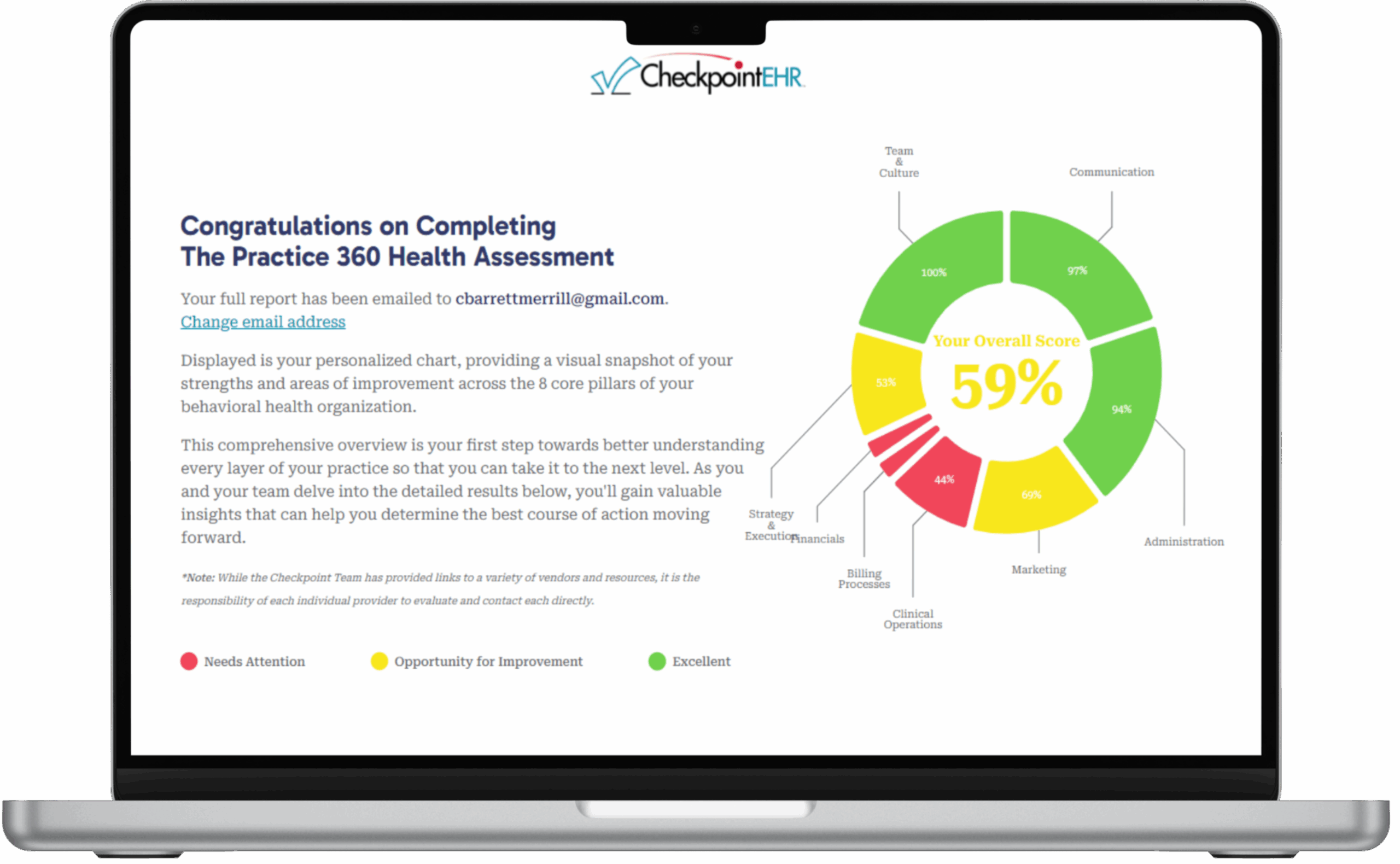Hiring and Retaining Therapists in a Market with >30% Annual Turnover

Mental health organizations across the U.S. face significant challenges when recruiting and retaining therapeutic staff. With an annual turnover rate exceeding 30%, it’s crucial to adopt effective strategies to attract, hire, and retain therapists. Checkpoint EHR is here to help. As a medical billing software company specializing in cloud-based solutions in healthcare, we have the expertise to guide your clinic toward successful growth.
Key drivers for clinician turnover include:
- Lack of cultural alignment (with staff or client type)
- Insufficient administrative and marketing support
- Low compensation or lack of benefits
- Preference for W2 or 1099 Employment
- Poor work-life balance
- Career changes for better opportunities
- Burnout
The Hiring-to-Retention Cycle: 4 Key Steps
To address these challenges, intentionality is required at each of the four steps in the Hiring-to-Retention Cycle:
- Know Your Culture and End Goals
- Draw in Candidates
- Hire the Best Fits
- Create a Retention Culture
1. Know your Culture and End Goal(s)
Culture is rooted in your clinic’s mission, vision, and values. Understanding who you are as a clinic will help define your goals and the type of team you need to achieve them. Key questions to consider:
- Does your team know your mission, vision, and values?
- Are these elements collaboratively developed and aligned with your team?
- Does your team share the same desire for growth or maintenance?
- Have you defined the ideal therapist fit in terms of personality, leadership style, clinical approach, and client type?
- Do you have systems for regular feedback from your team?
- What insights can be gained from exit interviews to inform future hiring?
Knowing your culture and the types of clinicians you seek helps narrow down potential hires, avoiding the costly consequences of premature turnover.
2. Draw in Candidates
Culture isn’t just internal; it influences how others perceive your organization. Questions to ask include:
- Is your practice known in your community?
- What are people’s first impressions of you?
- What attracts candidates to your organization over others?
To attract new candidates, consider logistical parameters. Ensure job descriptions include all possible requirements, distinguishing between negotiable and non-negotiable criteria. Establish a thorough evaluation and interview process, communicate timelines and next steps clearly, and ensure candidates can easily reach out to you.
Effective recruiting methods in the mental health industry include:
- Partnering with local universities and graduate programs
- Networking with local practices and referral networks
- Utilizing LinkedIn job listings and other job sites
- Posting on social media and your website
- Attending conferences and networking events
- Considering third-party recruiters for urgent needs
And, of course, the big question here is: Where do we find top mental health job candidates?
Some great starting points:
- Local Universities: Whether it’s attracting newly graduated associates or putting a
listing in an alumni campaign, being networked with graduate programs is always a good
idea! - Local Practices Agencies in your Referral Network: Clinics refer clients all the time
(either when they’re at capacity or not a good fit), the same applies to hiring. - Linkedin Job Listings and other Job Post sites: Make it easy for candidates to find
you. If they need a new job, they’ll be looking. (Also make sure to use the “Hiring” frame
on your Linkedin profile) - Social Media Posts: Make sure your followers know you’re hiring, and post regularly as
a reminder. - Popups and Banners on your Website: Similarly, if a prospect lands on your website,
make it obvious that you’re hiring and how to get in contact. - Conferences & Networking Events: The more people you know in the field, the more
people that can send clinicians your way. - If urgent, explore a Recruiter: While they can get expensive, if timing is more important
than the financial investment, it may be worth exploring third-party recruiting options (just
make sure they have some experience with clinical hiring!).
3. Hire the Best Fits
A well-defined workplace culture and intentional evaluation process make it easier to identify aligned candidates. During interviews, you can:
- Discuss case studies and clinical scenarios
- Conduct personality assessments
- Explore strengths and weaknesses
- Discuss long-term goals
- Evaluate understanding of your clinic’s mission and values
- Arrange interviews with other team members
- Request referrals
- Encourage candidates to ask their own questions
4. Create a Retention Culture
Retention begins the moment a clinician learns about your practice. Ensure that branding, communication, and expectations are clear and professional. Key considerations during onboarding include:
- Streamlined access to agency tools and software
- Efficient scheduling, paperwork, and communication processes
- Comprehensive understanding of your EHR system
- Availability for questions and discussions
- Additional support with marketing, client referrals, admin, and office setup
- Personal connection time with the team
- Smooth payroll processing and tax documentation
- Established team meetings and supervision
Effective onboarding helps new hires feel integrated and confident, contributing to a strong retention culture. Building this culture involves:
- Maintaining manageable client loads
- Offering competitive benefits and incentives
- Creating clear advancement pathways
- Budgeting for team and personal development
- Conducting regular 1:1 check-ins
- Staying updated with innovative tools and trends
- Supporting passion projects and continued training
- Measuring cultural satisfaction through surveys and metrics
By maintaining intentionality and alignment throughout the hiring and retention journey, you can build a resilient and committed team within your mental health organization, avoiding the pitfalls of high turnover. To learn how Checkpoint EHR plays a key role in this process, contact us today for more information.
Contact Checkpoint EHR Today

